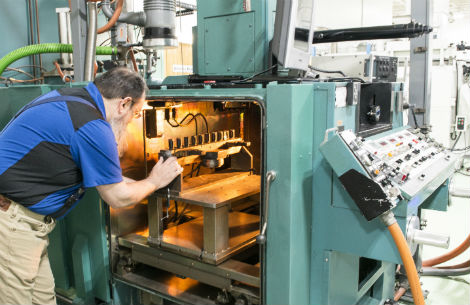
Since we started this blog a few months ago, we’ve written about a lot of topics related to laser welding, which hopefully you’ve found useful. Now we’d like to turn your attention to another type of welding that’s a favorite of ours – electron beam welding.
Electron beam (EB) welding is an excellent choice for joining advanced materials used in industries such as aerospace, semiconductors, and medical devices. Here are 10 advantages of EB welding. (I could come up with more, but 10 is a nice round number, isn’t it?)
- No gas contamination: Because EB welding is done in vacuum, there’s no atmospheric gas contamination. This results in the cleanest, highest-quality weld possible. For parts that require post-weld testing such as x-raying, EB welding is your best option.
- Less distortion and shrinkage: EB welding is a very controlled process with minimal shrinkage. The EB spot size is under .003”, which results in a very narrow weld and a very narrow heat affected zone. This minimal heat input results in less distortion and shrinkage. This is a major advantage for customers, since it allows finished parts to be welded without additional, post-weld processing.
- Excellent for refractory materials such as titanium, niobium, and tantalum. Since EB welding is done in a vacuum chamber, it prevents the exposure to oxygen that can cause these welds to fail. This is particularly an issue with welding titanium - if the welds are exposed to oxygen, it can cause a serious failure called alpha casing.
- Will not damage heat-vulnerable materials: Because of the low heat input of EB welding, temperature-sensitive parts can be located in proximity to the weld region.
- Ability to weld dissimilar metals: This is another area where EB really shines. EB is a robust process for joining copper to stainless steel, and copper to nickel-based alloys including Inconels and Hastelloys, which would not be practical with other processes.
- Flexible process: I’ve welded materials less than .001” thick and up to 4” thick with the same machine. It’s versatile enough to handle very deep to very shallow welds.
- Good for high volume, high quality welds: EB welding technology has made leaps and bounds in productivity and accuracy in the recent past. Antechambers eliminate the pump down time from the equation, and seam tracking eliminates operator expertise. EB is now a very robust process.
- Automation: EB welding has used CNC automation since the 1960s. In fact, some of the CNC EB machines that were built in the 1960s are still running today. EB welding has proven longevity and is a very stable, repeatable process.
- Reflective materials: Because the delivery system of the energy in EB welding is electrons, not photons, EB can easily weld highly reflective materials like copper, platinum, and Hastelloys. Most laser beams would bounce right off these materials.
- Highly efficient: EB welding is about 90 percent efficient – meaning 90 percent of the input power is reaching the part. That’s more important to us as welders rather than you the customer, but it’s another reason to love EB welding.
As you can see, there are many EB welding advantages that can provide solutions for your most challenging welding projects. We'll discuss these topics in more detail in future posts. In the meantime, if you have a question or comment, feel free to leave it in the space below.
And, as always, be sure to talk to a welding expert for the best recommendations on your particular project.









